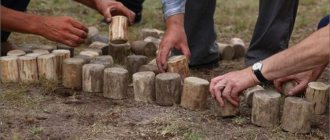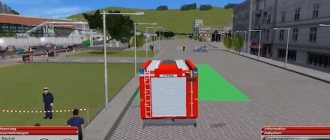Conkers
The game of chestnuts is loved by both children and adults. Before I tell you exactly how it is played, I’ll tell you a little about preparation, because this game cannot be played without it. To get started you will need a chestnut, a screwdriver and a string. Using a screwdriver, make a hole in the middle of the chestnut. This must be done carefully so as not to get hurt. After the hole is made, you need to thread a lace through it so that it hangs literally 5-6 centimeters from the other end. After this you need to make a knot. Now your instrument is ready!
Now the rules of the game itself. Your goal is to destroy the enemy chestnut. Using the game “paper, scissors, rock”, they decide who will strike first. The loser of the rock-paper-scissors game holds his chestnut on a string while his opponent hits him with his chestnut. The person who strikes first strikes until he misses. Then it’s the second player’s turn. If during the game the laces get tangled, then the right to hit goes to the one who shouts Snags first. If your opponent's chestnut falls to the floor, you can shout out Stamps, which will give you the right to trample the chestnut and win the game.
Austrian games for children
One of the popular Austrian games is “Four in a Room”. To play on the court, a square is drawn, each side of which is ten meters. Inside the square there is an inner room, outside the square there is an outer room. Four players stand inside the square, they are called “inside”, and four outside it, they are called “outside”. The “outside” players pass the ball to each other, and must unexpectedly throw the ball inside the square and hit one of the players. If the player misses or the opposing team catches the ball, the team is awarded a penalty point and the turn is given to the opponent. For every 4 penalty points, a player is removed from the team. The team with the most remaining players wins. Both teams are not allowed to cross the boundaries of the square.
Another popular game is called “The Great Hunt”. They play it in a large area, for example in a grove, planting, etc. One driver is selected, he is called a hunter, and all other players are called roe deer. The hunter has a whistle. All participants stand in a circle, the driver blows his whistle and everyone scatters. The hunter's task is to catch roe deer; if the hunter touches the roe deer, then it becomes his hostage and plays for him. The hunter must blow his whistle from time to time. The last roe deer not caught is considered the winner.
Also popular in Austria are games that are also popular in Russia - these are everyone’s favorite bouncers, dogs and the game “hot and cold”.
Finland Games
Finland has its own version of bouncers. To play, draw a circle with a diameter of 8 meters. There are players in the circle, and behind the circle is the driver with the ball. His task is to knock out the player. The player who was hit by the ball leaves the circle and begins to help the driver. The following players also join. The last one left in the circle wins. The next game is called “Who has the item?” The driver stands near the chair and counts to fifty, and all the players hide within the pre-agreed territory. One of the players has an object, for example, a ball. The driver must find the player and touch him, then he is eliminated from the game. The driver must touch the player. His main task is to find the player with the ball. The driver should not move far from the chair, because If the player who has the ball runs out and puts the object on the chair, then it is considered that the driver has lost. The game starts again. Players can move around and tell the player with the item where the driver is now.
Blind Man's Buff
This children's game from England is similar to our outdoor game "panas" ("blind man's buff"). One participant is the presenter, he is blindfolded, spun in place and released. All other participants scatter to the sides, and the leader’s task is to catch them. At the same time, the players clap their hands so that the leader understands which direction he needs to move. This game is played both outdoors and indoors. It’s even more fun indoors: you have to use various tricks to avoid falling into the hands of the host.
Pin the Tail on the Donkey
Another very funny game, the meaning of which is as follows: a drawing depicting a donkey without a tail is hung on a wall or some other hard surface. The players take turns blindfolded and given a paper tail. The player's task is to attach it to the correct place. You can see exactly what it looks like in the following video:
Sometimes, instead of a donkey, a drawing depicting Pinocchio without a nose is hung on the wall. The players' task is to attach the nose in place.
British Bulldog
This is a tag-based game. British bulldog is an outdoor game, and it requires space, so an open place is chosen: a field or a playing field. There are no restrictions on the number of players: the more, the merrier. The essence of the game is this: depending on the number of players, one or two “bulldogs” are selected. They stand in the middle of the playing field, at this time all other players are “in the house” (home), that is, to the left or right of the “bulldogs” at some distance. The task of those “in the house” is to run to the opposite side and not be caught by the “bulldogs”. If this fails, the player himself becomes a “bulldog”. The one who manages to remain undetected the longest wins. Game details may vary slightly depending on region. For example, in the video below, the goal of the “bulldogs” is to snatch the scarves from the rest of the participants.
Ring a ring o' roses
This game is most popular among young Britons, and is usually played in a kindergarten / a nursery school. Children dance in a circle and sing simple nursery rhymes:
Ring a ring o' roses, A pocket full of posies, Atishoo! Atishoo! We all fall down.
This happens as follows:
The game has a long and, according to some sources, very sad origins. An urban legend states that the game used to describe events occurring during the plague, but folklorists reject this explanation.
In and Out the Dusty Bluebells
Another active children's game. Children stand in a circle, hold hands and raise them high up. One of the players begins to run between those holding hands, and at this time everyone sings the following song:
In and out the dusty bluebells, In and out the dusty bluebells, In and out the dusty bluebells, Who will be my master?
Tippy-tippy tap-toe on my shoulder, Tippy-tippy tap-toe on my shoulder, Tippy-tippy tap-toe on my shoulder, You will be my master.
With the words tippy-tippy tap-toe on your shoulder, the player stands behind the closest of those holding hands, puts his hands on his shoulders and, lightly patting them, finishes the song. The song begins to be sung again, only now there are two players running between those holding hands. This continues until all players are in the “snake”. I would say that this game is vaguely reminiscent of our “trickle”.
Red Rover
This game is a complete analogue of our “forged chains”. They usually play in an open area. Players stand in two lines opposite each other, at a distance of 5-7 meters, more is possible. In each line, players hold hands. Next, one of the teams says the following phrase: Red rover, red rover, we call (player's name) right over. The person whose name was called must leave his line and run towards the enemy’s line. The goal is to break one of the “links” of the other team’s chain. If the player manages to do this, he takes one of the players from the broken “link” to his team. If it doesn’t work out, he himself becomes a player on the other team. There are different variations of the game, one of them can be seen in the video.
Hopscotch
And these are our good old classics. Squares are drawn on the asphalt with chalk in a certain sequence. The number of squares may vary, but usually no less than eight. The squares should be large enough to easily fit both feet. Players throw a small round object (a shooter), usually a pebble, onto each square in turn. Next, the player must jump onto each square with one or two feet, without stepping on its borders. If this rule is broken, the turn passes to the next player. The winner is the one who is the first to skip all the squares and return back to the starting point. Of course, there are different variations of the game.






